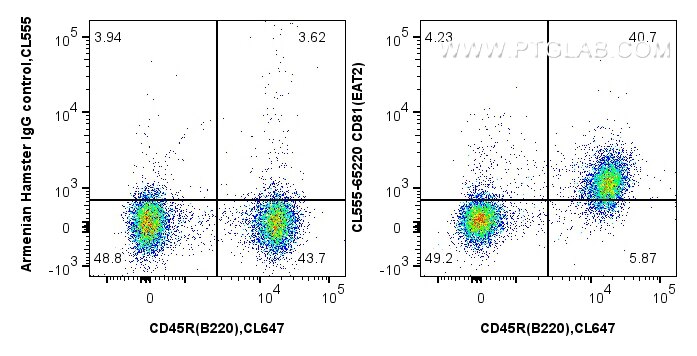CoraLite® Plus 555 Anti-Mouse CD81 (EAT2)
CD81 Monoclonal Antibody for FC
Host / Isotype
Armenian Hamster / IgG
Reactivity
mouse
Applications
FC
Conjugate
CoraLite® Plus 555 Fluorescent Dye
CloneNo.
EAT2
Cat no : CL555-65220
Synonyms
Validation Data Gallery
Tested Applications
| Positive FC detected in | mouse splenocytes |
Recommended dilution
| Application | Dilution |
|---|---|
| This reagent has been tested for flow cytometric analysis. It is recommended that this reagent should be titrated in each testing system to obtain optimal results. | |
| Sample-dependent, check data in validation data gallery | |
Product Information
CL555-65220 targets CD81 in FC applications and shows reactivity with mouse samples.
| Tested Reactivity | mouse |
| Host / Isotype | Armenian Hamster / IgG |
| Class | Monoclonal |
| Type | Antibody |
| Immunogen | CD81+ mouse B lymphoma 38C13 相同性解析による交差性が予測される生物種 |
| Full Name | CD81 antigen |
| GenBank accession number | BC011433 |
| Gene symbol | Cd81 |
| Gene ID (NCBI) | 12520 |
| Conjugate | CoraLite® Plus 555 Fluorescent Dye |
| Excitation/Emission maxima wavelengths | 554 nm / 570 nm |
| Form | Liquid |
| Purification Method | Affinity purification |
| Storage Buffer | PBS with 0.09% sodium azide. |
| Storage Conditions | Store at 2-8°C. Avoid exposure to light. Stable for one year after shipment. |
Background Information
CD81 (also known as TAPA1or TSPAN28) is a membrane protein of the tetraspanin superfamily, which are characterized by the presence of four conserved transmembrane regions. Many of these members are expressed on leukocytes and have been implicated in signal transduction, cell-cell interactions, and cellular activation and development. CD81 is involved in signal transduction and cell adhesion in the immune system (PMID: 9597125). CD81 has also been identified as an essential receptor for HCV (hepatitis C virus) (PMID: 21428934).
Protocols
| Product Specific Protocols | |
|---|---|
| FC protocol for CL Plus 555 CD81 antibody CL555-65220 | Download protocol |
| Standard Protocols | |
|---|---|
| Click here to view our Standard Protocols |


